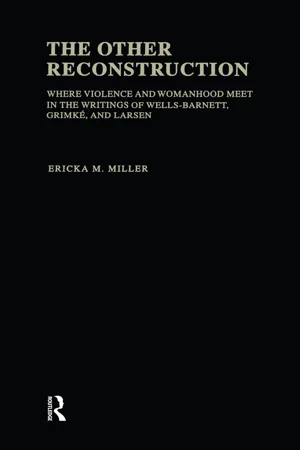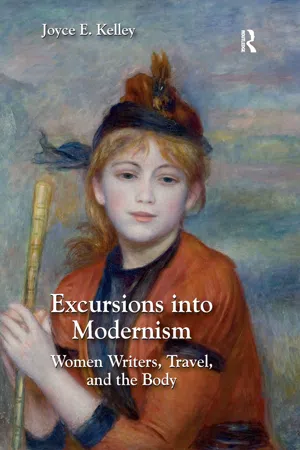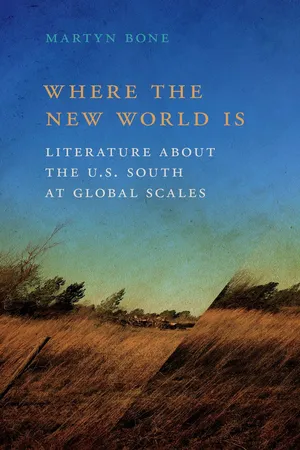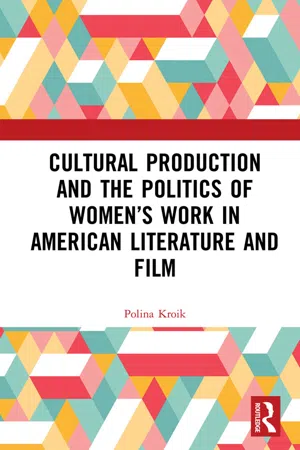History
Nella Larsen
Nella Larsen was an influential African American writer of the Harlem Renaissance in the 1920s. She is best known for her novels "Quicksand" and "Passing," which explore themes of racial identity and the challenges faced by biracial individuals in a segregated society. Larsen's work is celebrated for its nuanced portrayal of race, class, and gender in early 20th century America.
Written by Perlego with AI-assistance
Related key terms
5 Key excerpts on "Nella Larsen"
- eBook - ePub
The Other Reconstruction
Where Violence and Womanhood Meet in the Writings of Ida B. Wells-Barnett, Angelina Weld Grimke, and Nella Larsen
- Ericka M. Miller(Author)
- 2020(Publication Date)
- Routledge(Publisher)
In the early twentieth century, the new Negro became the icon of “the erotic, the exotic, and the innocent,” states duCille, the “ancient, primal and primitive… panacea for an overindustrialized society dying from an acute case of modernity.” Citing Sigmund Freud’s theories linking darker races to low-level civilization, uninhibited sexuality, and the mysterious female sexual self, as well as Sander Gilman’s work on the black female body as a centuries-old metaphor for excessive sexuality, duCille maps the racially feminized iconography of primitivism (73). 9 At the core of Nella Larsen’s Quicksand and Passing lies a struggle with this very problem: How does one avoid fixity in the pursuit of liberation? An examination of these novels, however, might benefit from some understanding of the author and her philosophy of art. In his biography of the writer, Thadious Davis approaches a characterization of Larsen the artist through her position in the “art versus propaganda” debate between black artists and intellectuals of the mid-to-late twenties, a point of contention so designated by other Renaissance scholars as well. Davis states that unlike those such as W. E. B. DuBois and Sterling Brown who believed that the truth of Negro experience in the United States was necessarily propaganda, Larsen insisted upon distancing her art from racial appeals. On this issue she was closer to those such as Alain Locke, who believed that the aesthetic should be the author’s first concern and that truth would necessarily follow. Though Larsen wrote about Negro life, albeit as experienced by the thin slice of the population known as the black elite, she sought appreciation of her work for the craft it demonstrated, not for any particular political statement it made - eBook - ePub
Excursions into Modernism
Women Writers, Travel, and the Body
- Joyce Kelley(Author)
- 2017(Publication Date)
- Routledge(Publisher)
Larsen found France particularly appealing; biographer Thadious M. Davis notes that in Paris “she found a social sphere that extended and magnified what she had experienced in Harlem during the heyday of the Renaissance in the 1920s” (Nella Larsen, 383). Portugal’s racial composition also fascinated Larsen: she remarked in a letter that over half the population was darker than she, and that many people in high positions had African traits (373). It is through these fresh concepts of race and identity and exhilarating glimpses of social freedom which travel revealed that we should read many works of the Harlem Renaissance, including Larsen’s fiction. Though Larsen traveled to Western Europe after the publication of her novels, she led a mobile existence throughout her life and often linked ideas of racial mobility to travel. Nella Larsen completed only two novels, but both these texts reveal her passionate absorption with issues of race, geographic movement, and identity. These concerns stem largely from her own experiences growing up as a biracial American. She was born in 1891 to a black Caribbean father and a white Danish mother, both foreigners trying to make a home for themselves in the United States. Coming from the Danish West Indies, Larsen’s father would have shared a common language with her mother; biographer George Hutchinson has surmised that this drew them together across racial boundaries (19). 7 When her father died and her mother remarried a white man, Larsen became racially out of place in a white family. The years she spent in Denmark with her mother as a child likely only increased her sense of racial difference. 8 She spent her life roaming from place to place, visiting Denmark again as a teenager and living in various locations in the United States, including Nashville, New York, and Tuskegee, thus remaining “unsettled,” as Deborah McDowell writes (x) - eBook - ePub
Where the New World Is
Literature about the U.S. South at Global Scales
- Martyn Bone, Jon Smith, Riché Richardson(Authors)
- 2018(Publication Date)
- University of Georgia Press(Publisher)
southern sign of Jim Crow. Today the level of interest in Larsen’s life and career, ranging across disciplines as disparate as African American studies and Scandinavian studies, is comparable to that of the Hurston revival. Yet years after Larsen’s own biographers dismissed her claims upon an Afro-Danish identity, Larsen’s transnationalism has remained difficult to square with disciplinary trends: in 2006 Patricia Chu warned that Larsen “is an example of an author whose work will suffer under an impetus toward nationalization of modernist studies.” But region too remains a relevant scalar unit for assessing Larsen’s fiction: throughout this chapter, I have tried to show that Quicksand and “Sanctuary” might benefit from a (new) southern studies approach that takes her representation of the U.S. South more seriously than earlier scholars have done. In Larsen’s first novel and final story, the South is not a static, distinct, or separate region; it is fluidly, intertextually, and inextricably connected to various national and transnational geographies. Chu notes too that there remains “very little discussion of Nella Larsen in terms of. . . racialized global modernization.” 65 This may be true, but Quicksand and “Sanctuary” render “global modernization” in racial and class terms: across the Atlantic, black U.S. southern, Danish, and British working classes alike must negotiate the shifting material realities of urbanization, industrialization, and technological modernization, not least through new forms of migration and labor relations. In ways we are only now beginning to fully fathom, Larsen’s fiction offers (to paraphrase Yaeger) yet wider reference points for remappings of the South’s social, economic, and racial coordinates: points beyond rural Alabama and “the Southern coast”; beyond Nashville and Atlanta; beyond even Chicago and New York, all the way to Copenhagen and rural Sussex. - eBook - ePub
Faulkner and Formalism
Returns of the Text
- Annette Trefzer, Ann J. Abadie(Authors)
- 2012(Publication Date)
- University Press of Mississippi(Publisher)
Light in August and Nella Larsen’s QuicksandMARTYN BONEThis essay provides a comparative analysis of William Faulkner’s Light in August (1932) and Nella Larsen’s Quicksand (1928). My starting point is that Faulkner and Larsen have more in common than one might assume if reading them only as exemplars of the Southern Renaissance and Harlem Renaissance respectively. More specifically, reading Faulkner alongside Larsen may help to resituate Faulkner’s “Southern” writing about race in wider national and transnational contexts.In Dirt and Desire: Reconstructing Southern Women’s Writing, 1930–1990 , Patricia Yaeger makes the parenthetical observation that “Nella Larsen’s reflections on the South in Quicksand (1928) and Passing (1929) offer still wider reference points for gendered remappings of the New South’s racial coordinates.”1 Yaeger does not pursue the point, but Quicksand remaps Southern “racial coordinates” via a narrative geography that is structured around multiple migrations. Quicksand’s protagonist Helga Crane travels not only between the South and the North, but also back and forth across the Atlantic between New York and Copenhagen. During these migrations, Helga also crosses the color line of U.S. racial ideology. Helga’s biracial identity and transnational triple consciousness (Negro, American, and Danish) challenge the rigid definitions of race that so restrict her life in the United States. My claim is that Joe Christmas’s peregrinations across regional, national, and racial boundaries in Light in August - Polina Kroik(Author)
- 2019(Publication Date)
- Routledge(Publisher)
Larsen’s attempt to conform to the modern girl figure might have been less significant had she continued publishing after the 1920s like some of the Harlem Renaissance authors. Yet Larsen’s professional and social success turned out to be short-lived. As the Depression loomed and Harlem writers found fewer ways to support themselves financially, the atmosphere became more competitive. After Larsen published the short story “Sanctuary” (1929), which was closely modeled on an earlier work of fiction by the British writer Sheila Kaye-Smith, male writers leveled charges of plagiarism at Larsen and attacked her for her association with Van Vechten. Around the same time Larsen found out about her husband’s ongoing affair with a white woman. As Larsen’s personal and professional world unraveled, she continued to perform the modern girl role, a role that entailed financial and psychological dependence. Larsen seems to have repudiated her professional careers in nursing and librarianship along with the relative autonomy that these careers afforded. Even as Larsen realized that writing required sustained work, she apparently stopped short of defining herself as a professional writer in the way that Edith Wharton did. Instead Larsen characterized the labor of writing in negative, racialized terms and seemed to regard the modern girl persona as integral to her work. The insistence of keeping to that role both socially and creatively helps explain Larsen’s breakdown and disappearance in the 1930s. With the shifts in the social milieu and Harlem’s cultural institutions, and the upheavals in Larsen’s personal life, this role became untenable.With the publication of Quicksand and Passing, Larsen became a well-known figure in the world of letters. She was invited to speak at the 135th Street Public Library where she had previously served as a children’s librarian, gave interviews, and attended parties alongside with the stars of black and white modernism (Hutchinson). In 1929, she won a Guggenheim Fellowship to support travel to Europe. This success, however, did not result in financial stability for Larsen and her husband, Elmer Imes. A practice then current in the publishing industry drastically reduced novel prices a short time after the initial publication. Though Elmer Imes drew a regular salary as a research physicist, that salary was not enough to sustain the couple’s high living standard. When Larsen submitted the short story “Sanctuary” to Forum
Learn about this page
Index pages curate the most relevant extracts from our library of academic textbooks. They’ve been created using an in-house natural language model (NLM), each adding context and meaning to key research topics.




